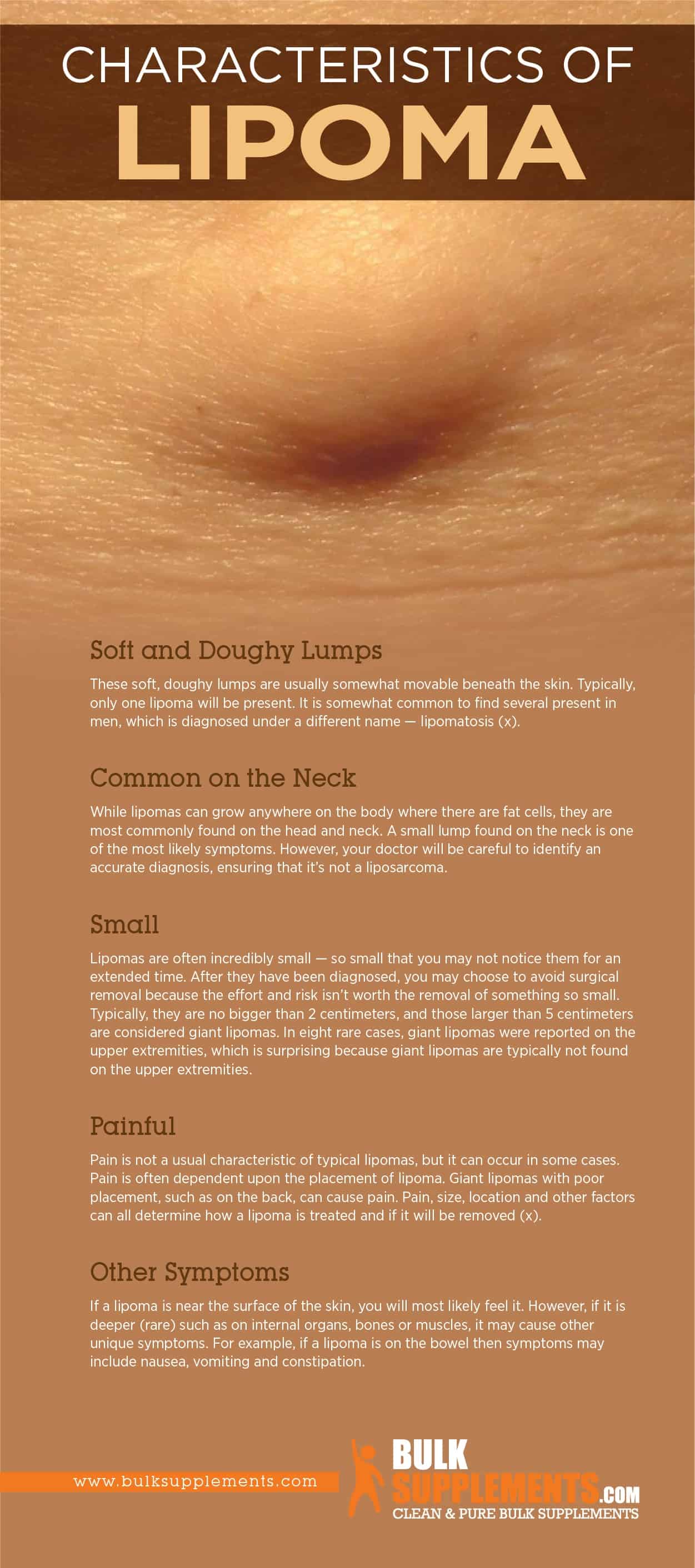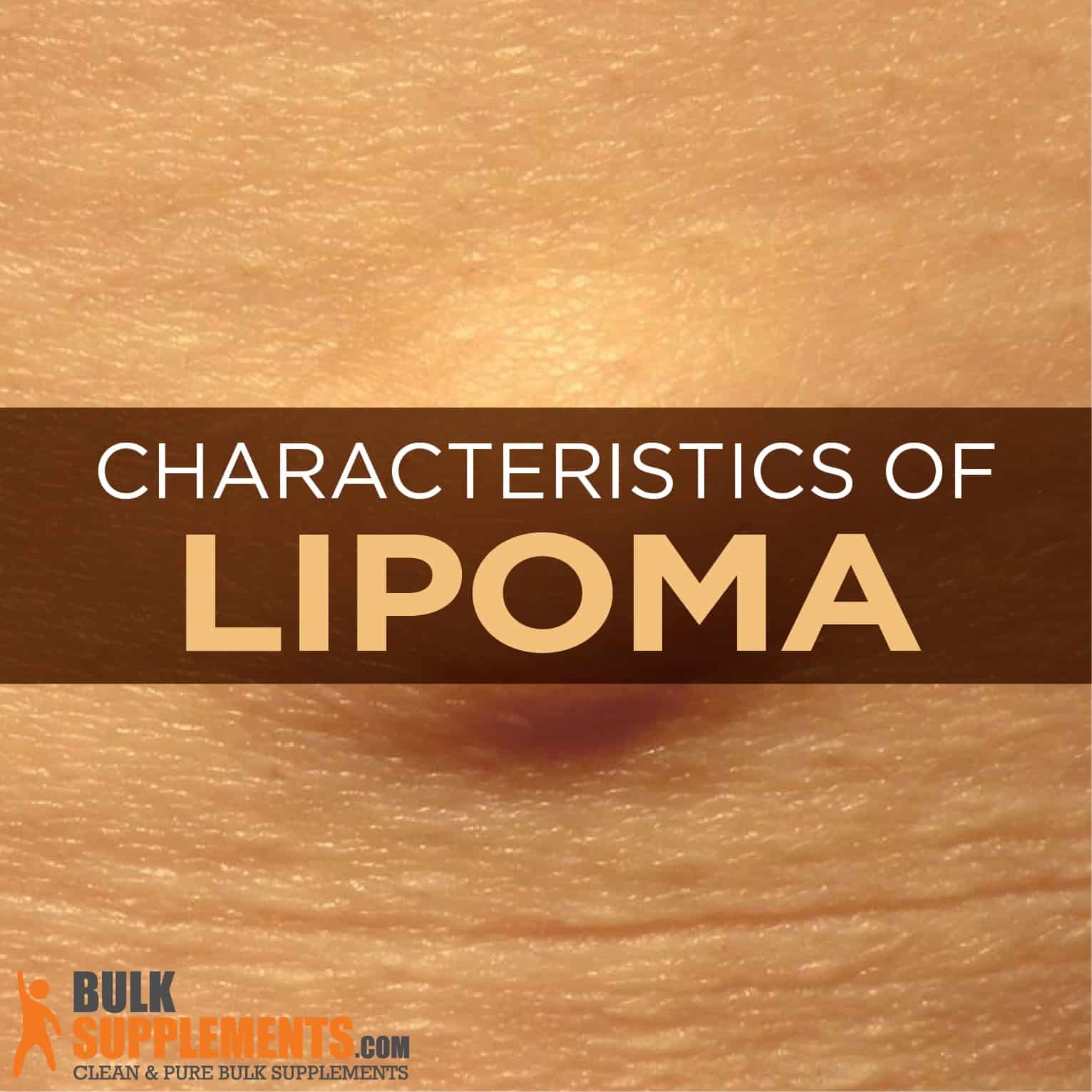What is a Lipoma?
A lipoma is a non-cancerous growth under your skin as small lumps occur because of an overgrowth of fat cells. Lipomas may occur anywhere there are fat cells, but they most commonly appear on the shoulders, chest, neck, thighs and armpits. These lumps rarely show up on internal organs, bones or muscles but they can, causing some health concerns. While lipomas are usually only 2-3 centimeters in size, some can become very large, greater than 10 centimeters.
The medical industry does not know what exactly causes these growths, but there are risk factors, including probable genetic causes. Treatments range from doing nothing to natural remedies to surgery, depending on placement, size and other factors. Supplements are also available to help support general health and play a role in treatment.
Liposarcoma vs. Lipoma
A liposarcoma is a cancerous growth. Also called sarcoma, it looks very similar to a lipoma, which is why your doctor will take extreme caution when first diagnosing your lipoma. Besides being cancerous, other differences are that liposarcomas are typically more painful, grow faster and are less movable.
Lipomas are also different from cysts because cysts typically contain a creamy and foul-smelling substance.
Lipoma Characteristics
- Soft and Doughy Lumps
These soft, doughy lumps are usually somewhat movable beneath the skin. Typically, only one lipoma will be present. It is relatively common to find several present in men diagnosed under a different name — lipomatosis. (x)
- Common on the Neck
While lipomas can grow anywhere on the body where there are fat cells, they commonly form on the head and neck. A small lump found on the neck is one of the most likely symptoms. However, your doctor will be careful to identify an accurate diagnosis, ensuring that it’s not liposarcoma. (x)
- Lipomas are Small in Size
Lipomas are often incredibly small — so small that you may not notice them for an extended time. After diagnosis, you may choose to avoid surgical removal because the effort and risk aren’t worth removing something so small.
Typically, they are no bigger than 2 centimeters, and those larger than 5 centimeters are giant lipomas. In eight rare cases, giant lipomas form on the upper extremities, which is surprising because giant lipomas rarely form on the upper extremities. Four men and four women age 15 to 70 had massive fatty tumors, where one proved to be liposarcoma after being removed. (x)
- Painful
Pain is not a typical characteristic of typical lipomas, but it can occur in some cases. Pain often depends on the placement of the lipoma. Giant lipomas with poor placement, such as on the back, can cause pain. Treatment or removal of lipomas depends on pain, size, location and other factors. (x)
- Other Symptoms
If a lipoma is near the surface of the skin, you will most likely feel it. However, if it is deeper in your body (rare), such as on internal organs, bones or muscles, it may cause other unique symptoms. For example, if a lipoma is on the bowel, symptoms may include nausea, vomiting and constipation.
Lipoma Causes
There is no known cause of lipomas. In 2 to 3 percent of cases, individuals inherit a gene from their parents, making their bodies more likely to generate a lipoma. Its name is familial multiple lipomatosis. Some researchers believe that they may result from blunt force trauma or injury to a specific area. Other medical conditions that may contribute to them include Gardner’s syndrome, Cowden syndrome, Madelung’s disease and adiposis dolorosa. The first two health conditions may lead to multiplied fatty lumps under the skin. Madelung’s disease is a rare health concern that affects how your body stores fat. Adiposis dolorosa is painful, under the skin fatty deposits, specifically in obese women. (x) (x) (x)
Lipoma Risk Factors
While what causes lipoma is only speculative or unknown, there are risk factors to consider. Around one percent of people will have them in their lifetime. Individuals with close family members that have them will often develop one as well. Other risk factors include:

Lipoma Remedies and Supplements
Consider using natural remedies for this health concern since it’s not all that serious, and the only drawback is your vanity if others can see a lipoma, like on your head, neck or arm. Make sure you discuss the benefits and possible adverse effects of taking supplements before you start. Some supplements to consider:
- Turmeric for Lipomas
Although lipomas are not a cause for concern, most people still want to know how to treat them. Turmeric is one natural remedy with few side effects. For centuries, positive turmeric influence as a healing herb started in ancient Indian medicine. When using this supplement, take 1,000 mg daily or as directed by a physician.
Turmeric can also be made into a paste with equal parts olive oil and turmeric powder. For instance, one teaspoon of turmeric and one teaspoon of olive oil, form a paste and apply to the lipoma. (x)
- Fish Oil
If you’re not a fan of eating too much fish, fish oil is an excellent replacement and an excellent remedy for lipomas. Fish has healthy omega-3 fats and quality protein. Omega-3 fats specifically help decrease inflammation and may help prevent their growth. Fish oil is also high in vitamin B12. (x) (x)
- Sage
Sage is a natural blood thinner, but it also helps balance the fluids in the body overall. A collection of fatty tissue such as in a lipoma may indicate an imbalance of fluids. It is where sage comes in. Balancing these fluids may prevent these strange growths. As a dietary supplement, take 3,200 mg or as directed by a doctor. (x)
- Apple Cider Vinegar
Apple cider vinegar has a high acetic acid concentration. For lipomas, acetic acid can be helpful in both decreasing inflammation, preventing fat from depositing and improving metabolism. Ginger and raw honey have similar benefits.
Where to Buy Supplements for Lipoma?
You can purchase these supplements to help with lipoma at BulkSupplements.com. The company is an industry-leading manufacturer and distributor of pure dietary supplements.
BulkSupplements.com is not just a consumer brand. It also supplies pure ingredients to other food and supplement brands to make their products. All products at BulkSupplements.com are manufactured and tested according to current and proper manufacturing practices.
Are you interested in trying any of these supplements mentioned in this article as a possible solution to help you with lipoma? Contact BulkSupplements.com to place an order today.
Other Remedies and Supplements for Lipoma
In the event that you cannot prevent or help ease your lipoma with any of these natural remedies and supplements, other medical treatments are available. Your doctor will determine whether or not you need surgery, liposuction or a steroid injection to remove them.
The Bottom Line
If you notice a small, soft, doughy lump on your body, you should make an appointment with your doctor to make sure that it is a lipoma. They will diagnose it and help you plan a treatment strategy. It is essential to see a doctor even if you think it’s nothing serious because liposarcoma has similar but cancerous characteristics.
It is unknown how lipomas occur, but the small buildup of fat cells is a more cosmetic issue than anything else. Fortunately, lipomas are generally small (approximately 2 cm) and therefore are not difficult to cover if you want to protect or hide them. When they are larger than 5 centimeters, the medical industry calls them giant lipomas, and these often require removal because they can cause pain and are a cosmetic issue.
These statements have not been evaluated by the Food and Drug Administration. These products are not intended to diagnose, treat, cure or prevent any disease.


